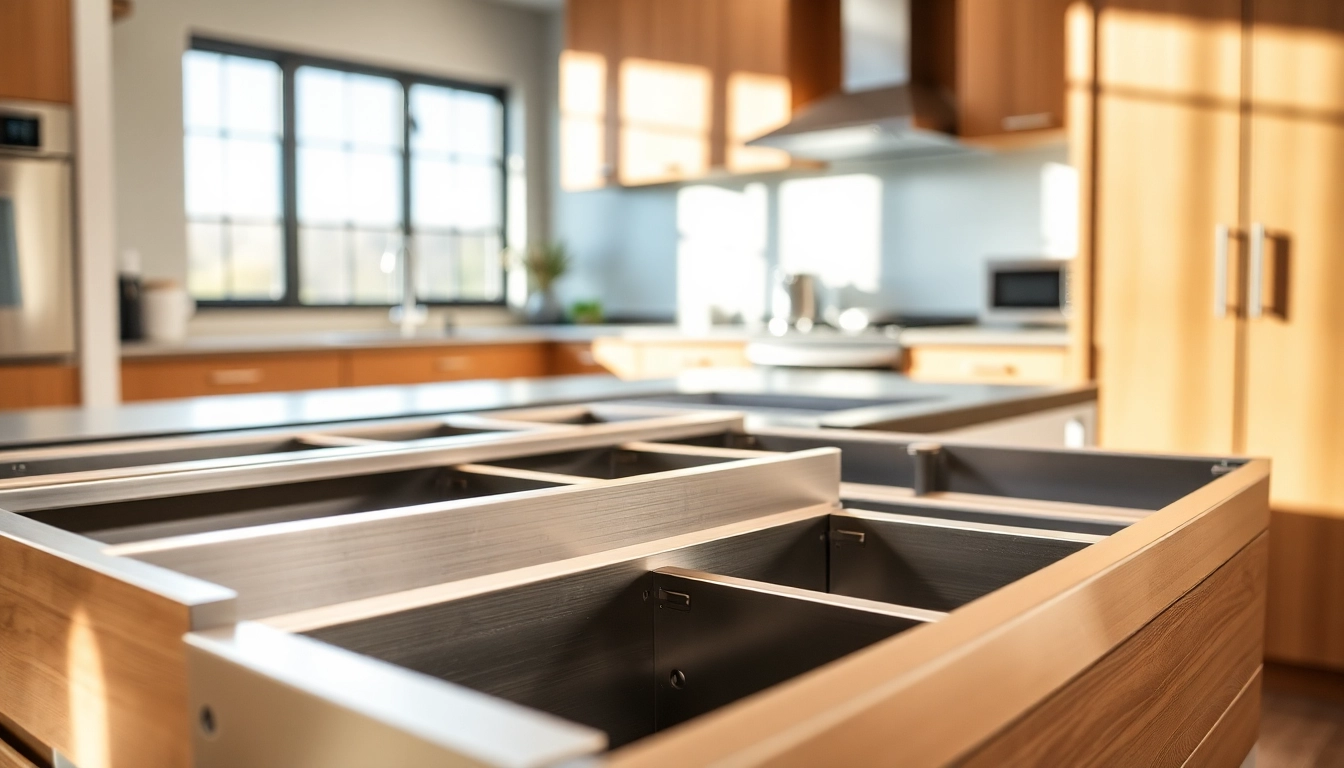In the realm of storage solutions, Metal Drawer Systems stand out for their durability, efficiency, and aesthetic appeal. They are not just components of furniture but essential elements that transform spaces, making them more organized and functional. Understanding the intricacies of metal drawer systems is vital for homeowners, designers, and manufacturers alike. This article aims to provide a comprehensive overview of metal drawer systems, detailing their benefits, types, installation, maintenance, and future trends, ensuring readers are well-equipped to make informed decisions.
Understanding Metal Drawer Systems
What is a Metal Drawer System?
Metal drawer systems are storage units typically installed within cabinetry or as standalone components. They consist of drawers that are engineered using various metals, primarily steel or aluminum, which provide rigidity and strength. Unlike traditional wooden drawers, metal systems are designed to maximize space usage and improve functionality through innovative engineering. Their construction often includes features like soft-closing mechanisms and ball-bearing slides that ensure smooth operation, enhancing user experience.
Benefits of Metal Drawer Systems
Metal drawer systems come with numerous advantages, making them a preferred choice across different applications:
- Durability: Metal drawers resist warping, splitting, and damage from moisture, making them ideal for kitchens, bathrooms, and high-humidity areas.
- Weight Capacity: They can support heavier loads compared to wood systems, making them suitable for storing tools, equipment, and other heavy items.
- Aesthetics: With sleek designs and finishes, metal drawer systems can add a modern flair to any interior design.
- Easy Maintenance: Their surfaces can be cleaned easily and are resistant to staining and scratching, ensuring long-term attractiveness.
- Efficiency: Features like full extension glides and soft-close systems enhance usability, allowing for better organization and accessibility.
Types of Metal Drawer Systems Available
Metal drawer systems vary in type, design, and application. Some common types include:
- Standard Drawer Slides: Basic systems that allow drawers to slide in and out smoothly. Most come equipped with ball bearings for enhanced movement.
- Soft-Close Mechanisms: Designed to gently pull the drawer closed, preventing slamming and providing a quieter experience.
- Heavy-Duty Drawers: Built for industrial and commercial applications, these drawers can support substantial weight while still maintaining ease of operation.
- Undermount Systems: These are installed beneath the drawer box, providing a clean look and facilitating easy removal of the drawers for maintenance.
- Full-Extension Drawers: Allow full access to the contents of the drawer, optimizing storage capabilities.
Choosing the Right Metal Drawer System
Factors to Consider When Selecting
When choosing a metal drawer system, several factors should be taken into account, including:
- Load Capacity: Assess the weight of items you intend to store. Opt for heavier-duty options for greater capacity.
- Space Constraints: Ensure the drawer dimensions fit your space requirements, considering both width and height.
- Accessibility: Choose systems that offer features such as smooth-glide or soft-close for optimal usability.
- Design Compatibility: Select styles and finishes that align with your overall decor for a cohesive look.
- Budget: Establish a budget taking into account the total cost of the drawer systems, including installation if needed.
Common Materials Used in Metal Drawer Systems
Metal drawer systems are primarily constructed from materials such as:
- Steel: Known for its high strength and durability, steel is often galvanized or finished to prevent rusting.
- Aluminum: Lightweight and resistant to corrosion, aluminum is ideal for applications requiring transportability.
- Stainless Steel: Offers an attractive finish and is resistant to both rust and staining, making it perfect for kitchen environments.
Customization Options for Metal Drawers
One of the standout features of metal drawer systems is the potential for customization:
- Size Variability: Drawers can be manufactured to fit specific dimensions required by the user.
- Color Choices: Finished in various colors and textures, offering the ability to match interior decor.
- Functional Features: Options such as dividers, organizers, and compartments can be included to optimize space.
Installation and Maintenance of Metal Drawer Systems
Step-by-Step Installation Guide
Installing metal drawer systems can be straightforward, and following these steps can ensure a seamless process:
- Gather Tools and Materials: You will typically need a drill, screws, measuring tape, level, and a screwdriver.
- Measure and Mark: Determine the exact placement of the drawer slides on the side walls of the cabinet. Mark drill points with a pencil.
- Attach Drawer Slides: Using a drill, attach the slides to the cabinet, ensuring they are level to allow proper functioning.
- Attach Drawer Box: Secure the corresponding slides to the drawer box, ensuring they align properly.
- Test Functionality: Insert the drawer into the cabinet and check for smooth operation. Make adjustments to alignment if necessary.
Tips for Maintaining Your Metal Drawers
Proper maintenance will prolong the life of your metal drawer systems:
- Regular Cleaning: Wipe down surfaces regularly to eliminate dust and dirt accumulation.
- Lubrication: Periodically apply lubricant to the slides to maintain ease of movement.
- Check & Tighten Hardware: Inspect screws and fittings to ensure they remain secure over time.
Common Issues and Solutions
While metal drawer systems are designed for durability, users may encounter some issues:
- Drawer Sticking: Adjusting the alignment of the slides often resolves sticking drawers.
- Noisy Operation: This could be due to lack of lubrication; a quick application of grease can solve this problem.
- Rust Formation: Ensure you keep metal surfaces dry and consider using stainless steel or powder-coated options for corrosion resistance.
Comparing Metal Drawer Systems to Other Materials
Metal vs. Wood Drawer Systems
When comparing metal and wood drawer systems, there are several critical contrasts to consider:
- Durability: Metal is generally more durable than wood, especially in environments subject to temperature changes.
- Maintenance: Metal requires less maintenance, as it is less prone to damage from water and wear.
- Aesthetic Flexibility: While wooden drawers offer a classic look, metal can provide a modern, clean aesthetic that may appeal to contemporary design sensibilities.
Durability and Aesthetics of Metal Drawers
Metal drawers shine in both durability and aesthetic appeal:
- Longevity: The structural integrity of metal ensures that these systems outlast wooden counterparts, particularly in demanding environments.
- Design Options: With varied finishes and styles, metal drawers can complement a range of interior designs, from industrial to minimalist.
Cost Considerations
Cost plays a significant role in deciding between metal and wood drawer systems:
- Upfront Cost: Metal drawer systems may have a higher initial price compared to wood; however, their longevity can result in cost savings over time.
- Overall Value: Consider the total cost of ownership, which includes maintenance and replacement frequency.
Future Trends in Metal Drawer Systems
Innovative Features in Modern Metal Drawers
The market for metal drawer systems is rapidly evolving, introducing advanced features such as:
- Smart Technology: Integration with smart home systems allows for features such as automatic opening or closing.
- Environmentally Friendly Materials: Increased demand for sustainable practices is leading manufacturers to explore eco-friendly metal options.
- Custom Design Software: Online tools are becoming available, enabling consumers to design their drawer systems prior to purchase.
Environmental Impact and Sustainable Options
As awareness of environmental issues grows, manufacturers are seeking to minimize the carbon footprint:
- Sourcing: Responsible sourcing of metals can drastically reduce the environmental impact associated with metal drawer production.
- Recyclability: Metal is highly recyclable, which provides an advantage concerning waste management compared to other materials.
Predictions for the Future of Drawer Systems
Looking ahead, the following trends are likely to shape the future of metal drawer systems:
- Increased Customization: Consumers will seek more personalized drawer systems tailored to their specific storage needs and aesthetic preferences.
- Smart Home Integration: As homes become smarter, there will be a push for drawer systems that work seamlessly with existing technology.
- Greater Emphasis on Functionality: Features that enhance user experience will continue to evolve, ensuring that the practicality of drawer systems keeps pace with design trends.



